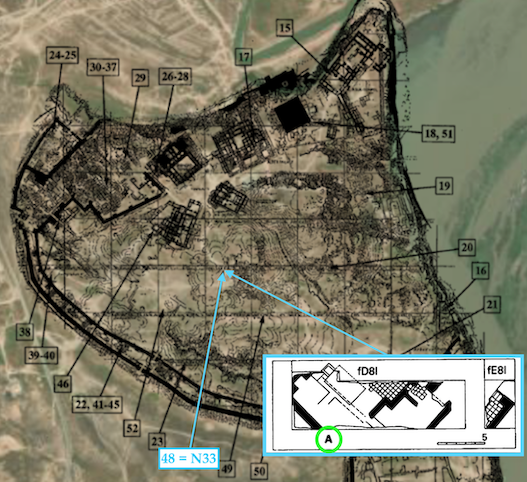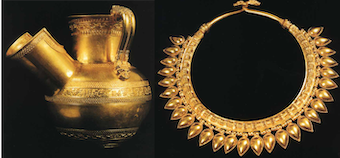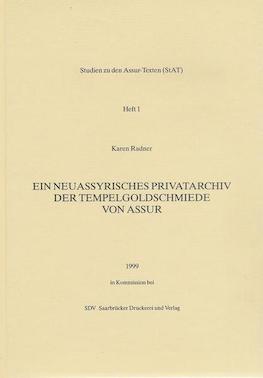You are seeing an unstyled version of this site. If this is because you are using an older web browser, we recommend that you upgrade to a modern, standards-compliant browser such as FireFox [http://www.getfirefox.com/], which is available free of charge for Windows, Mac and Linux.
The N33 Archive (the Goldsmiths' Archive)

This sub-project of the Archival Texts of the Assyrian Empire (ATAE) [/atae/index.html] Project includes open-access versions of the sixty-two Neo-Assyrian texts (with German translations) edited in Karen Radner's Ein neuassyrisches Privatarchiv der Tempelgoldschmiede von Assur (Studien zu den Assur-Texten 1), Saarbrücken, 1999. All of these inscribed tablets originate from the N33 archive at Assur.
The N33 Archive (the Goldsmiths' Archive)

Satellite image of the ruins of Assur overlaid with a general plan of the archives and libraries (Pedersén, Archives and Libraries in the Ancient Near East 1500-300 B.C. p. 133 Plan 62) and showing the approximately location of the N33 Archive (the Goldsmiths' Archive). Image preapred by Jamie Novotny.
The texts of the Assur archive N33 were found in the debris of a residential building with a courtyard and family tomb in June 1908, during the excavations headed by Walter Andrae. The house was only partially excavated: the clay tablets were found in a section of the building exposed in grid square fD8I and it is possible that the architectural remains in grid square fE8I belong to the same house. As many other houses excavated in Assur, the building was destroyed by fire during the conquest of the city in 614 BC and the excavations unearthed a 0.75-m-high, burnt destruction layer in its rooms.
The house was well built and constructed on top of the walls of an earlier building, and it integrated elements of the older architecture, most importantly the underground family tomb. The clay tablets of the N33 archive (consisting of two lots of texts with the excavation numbers Ass 13846 and Ass 13850) were found in a niche that was set into a wall of the main room, underneath of which was the family crypt. This room's plastered walls were painted red, with black stripes along the bottom, and the floor was paved with bricks and pebbles. Not only was the room nicely decorated, it was also comfortably furnished. Several metal fittings were excavated that are presumably the only remains of the long-gone wooden furniture. There was also a clay lamp and various ceramic and basalt vessels, including a mortar, as well as numerous terracotta figurines, pearls and an ivory stamp seal.
The contents of the archive indicate that the house was inhabited by the goldsmith Nabû-zeru-iddina and his family, who lived there from the reign of Ashurbanipal (r. 668–ca. 631 BC) until the fall of Assur in 614 BC. As is typically the case with the everyday documentation of the Neo-Assyrian Period, only legal texts were dated. The earliest documents date to the years 661 BC (VAT 8643 [/atae/stat1/X900501/]) and 654 BC (VAT 8651 [/atae/stat1/X900503/]), but most dated texts from the N 33 archive give a so-called "post-canonical" eponym year, meaning that they date to the period after 648 BC, which is not covered by the extant manuscripts of the Assyrian Eponym List [/saao/saas2/index.html]. Because many members of the family can be shown to have shared Nabû-zeru-iddina's profession, the archive is known as the "Goldsmiths' Archive." The extended goldsmith family was in the service of the Aššur temple and presumably worked in the temple workshop where divine statues and cultic equipment were created on hallowed ground. But with the exception of two letters (VAT 8644 [/atae/stat1/X900548/] and VAT 15545 [/atae/stat1/X900543/]), the texts in their archive do not concern their work as goldsmiths.

Gold vessel and necklace from the royal tombs discovered at Kalhu (modern Nimrud) discovered in April of 1989 by an expedition of the Iraqi Department of Antiquities and Heritage. Photo credit: AINO [http://www.aina.org/nimrud/nimrudtreasures.htm].
The Goldsmiths' Archive consists of private letters, legal documents and various lists. The legal texts include purchase contracts for buildings and people, debt notes for silver and textiles, and judicial texts documenting court proceedings. The lists enumerate textiles or persons or are related to the financing of commercial activities. The archive's texts document two main business interests that members of the family pursued: money lending and investing in trade ventures, particular in the import of wine (for which see also the contemporary archive of Duri-Aššur [/atae/wvdog152/index.html]). Furthermore, two house purchase contracts reveal an interest in acquiring real estate – at Assur, the preserve of the very wealthy. On several occasions, the family's business interests seem to have led to disputes that needed to be settled in court, as evidenced by judicial agreements and also letters.
The Goldsmiths' Archive has not yet yielded all its secrets. Four of its clay tablets were written in an otherwise unattested variant of the cuneiform script and these texts have not been deciphered, even more than twenty years after the archive's publication.

The texts of the archive were published and analysed by Karen Radner, Ein neuassyrisches Privatarchiv der Tempelgoldschmiede von Assur (Studien zu den Assur-Texten 1), Saarbrücken, 1999. StAT 1 can be bought from Harrassowitz Verlag [https://www.harrassowitz-verlag.de/titel_3324.ahtml]. The ink drawings of the tablets were published by Karen Radner in Liane Jakob-Rost, Karen Radner and Veysel Donbaz, Neuassyrische Rechtsurkunden II (Wissenschaftliche Veröffentlichungen der Deutschen Orient-Gesellschaft 98 / Keilschrifttexte aus Assur aus neuassyrischer Zeit 2), Saarbrücken, 2000. WVDOG 98 can also be purchased from Harrassowitz [https://www.harrassowitz-verlag.de/Neuassyrische_Rechtsurkunden_II/titel_3331.ahtml].
Click here [/atae/stat1/pager] to browse the StAT 1 corpus.
ATAE is a key component of the Archival Texts of the Middle East in Antiquity (ATMEA) sub-project of the LMU-Munich-based Munich Open-access Cuneiform Corpus Initiative [https://www.en.ag.geschichte.uni-muenchen.de/research/mocci/index.html] (MOCCI; directed by Karen Radner and Jamie Novotny). Funding for the ATAE corpus project has been provided by LMU Munich and the Alexander von Humboldt Foundation (through the establishment of the Alexander von Humboldt Chair for Ancient History of the Near and Middle East).
For further details, see the "About the project" [/atae/abouttheproject/index.html] page.

Home Page banner credit
Gold objects from the royal tombs discovered at Kalhu (modern Nimrud) discovered in April of 1989 by an expedition of the Iraqi Department of Antiquities and Heritage. Photo credit: AINO [http://www.aina.org/nimrud/nimrudtreasures.htm].
Karen Radner
Karen Radner, 'The N33 Archive (the Goldsmiths' Archive)', Studien zu den Assur-Texten 1 (StAT 1), Ein neuassyrisches Privatarchiv der Tempelgoldschmiede von Assur (StAT 1). Original publication: Harrassowitz Verlag, 1999; online contents: ATAE/StAT 1 Project, a sub-project of MOCCI, 2023 [http://oracc.org/atae/stat1/]